The history of automotive design is siloed and secretive with collaboration reserved for special partnerships, but when it comes to sustainability, even with combustion engines being phased out for electric and hydrogen power, progress is not quick enough.
With car manufacturers owning so much proprietary information and IP, Lexus (which is owned by Toyota) is proposing that making research and development open source will help achive the collective goal of cleaning up an industry with a whopping carbon debt and an uncertain future.
Today car companies are beginning to engage with the hot topic of regenerative design and will need to recycle on an industrial scale, reusing materials wherever possible.
For their part Lexus (and Toyota) are focusing on looking just as carefully at supply chains and materials as the power trains of new cars in a bid to become a carbon net zero company by 2050.
According to Lexus’ Calty Design Research chief designer and studio resource manager Alex Shen, collaborative thinking has always been a topic of conversation within Lexus. The company was particularly proud of its hybrid technology which is why the design team was “willing to share it”, says Shen, adding that he thought it could “help a lot of other car companies”.
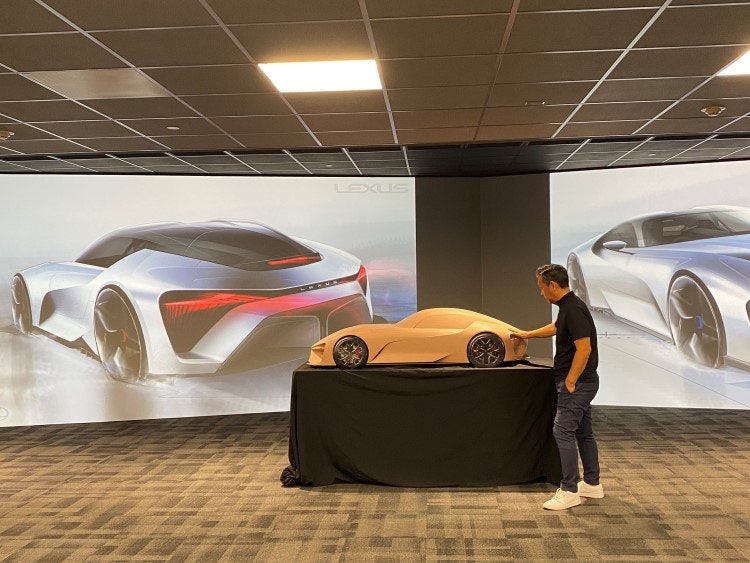
It is also evident from the Lexus’ partnerships over the last decade that it is no stranger to platform-sharing. Most recently, Lexus started a relationship with Mazda in 2019 to develop a second-generation Lexus RC coupe. With Toyota it co-developed the GT86 with Subaru, released in 2013, and worked on its Supra project, released in 2018, alongside BMW.
In Shen’s opinion, “the days of competitive nature” and hiding new ideas from other companies are over, especially when it comes to sustainability. He says that “collaboration is the key to quicker improvement”, which is necessary to reach carbon neutrality goals by 2050.
As with other industries, such as furniture and product design, making serious changes to become more environmentally conscious disrupts everything, including entire business models in some cases. Though Lexus has committed to carrying out the necessary research, Shen says, “the more we look into it the heavier the topic becomes”.
He adds that “open-source thinking is good” and believes it is something that Lexus will continue to do in the future. If open-source thinking is adopted across the industry, Lexus should also benefit from the research of others.
Shen says companies need to “move forward carefully but also quickly”, explaining that the past couple of years have been spent “really focusing on learning what the best solutions are”. He hints that there is currently a project relating to those solutions in the works at Lexus.
“Quality is part of sustainability”
Since Lexus is the luxury vehicle division of Toyota, its users naturally expect a certain level of quality, performance and technology. From a design perspective, Shen says the Calty team seek to make cars that “people can fall in love with” and will want to keep for longer. “Let’s eliminate the thinking that you should change your car every three years”, he adds. The result – and another sustainable solution for the auto industry – would be a decrease in the number of cars being manufactured.
The notion of repairing instead of replacing is another point of discussion within Calty design studio. Generally, electric motors have simple mechanics with most of the power in the battery, which loses chargeability over time. Because of this, Shen says it is possible to transfer batteries from high performance cars to models “that don’t require a high level of performance” to extend the battery’s lifespan. He adds that there have been talks of “future-proofing” technology and designing it to be updateable rather than replacing it.
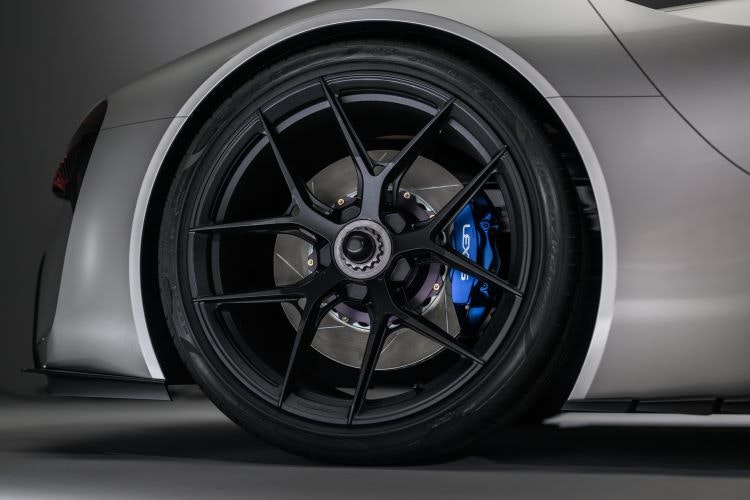
From a material perspective, Shen says Lexus is doing all it can in terms of “lifecycle management and how it treats materials”, though he admits there are limitations in some areas. Choice of sustainable exterior materials are limited, and sourcing sustainable tyres is “a big issue” that the company is trying to deal with, he explains. This isn’t surprising given that more is now known about tyres being a microplastic pollutant as they wear down in addition to having a significant carbon impact when made.
Despite this, Lexus is thinking about longevity when it comes to material choices by opting for those which “don’t break easily and are long-lasting,” according to Shen.
“It’s not all about zero”
Though carbon neutrality is a key focus for Lexus, it is “not an easy task to address every problem”, says Shen, adding, “it’s not all about zero, it’s about the best we can do”.
The Beyond Zero series seeks to maintain this mindset as it incorporates vehicles into Lexus’ sustainable portfolio that satisfy customers in different price brackets. The costs associated with reaching net zero goals can often push up the price of a vehicle, making it unaffordable for a large proportion of customers.
Shen says the Beyond Zero series is about making sure “customers are happy at every level, and that they can be part of Lexus’ sustainability direction. The challenge appears to be striking a balance between providing enough options and keeping the beyond zero mindset at the forefront of their designs.
Lexus’ Takumi spirit
The new Lexus Electrified Sports Concept, which recently made its debut outside of Japan, embodies Lexus’ vision of a future all-electric, high-performance model. Its design takes on recognisable sports car features including the proportions of its cabin back and long hood, and a low ride height, with enhanced performance potential coming from its electric powertrain and solid-state battery technology. According to Shen, the concept vehicle is a spiritual successor to the Lexus LFA V10 supercar, released in 2010.
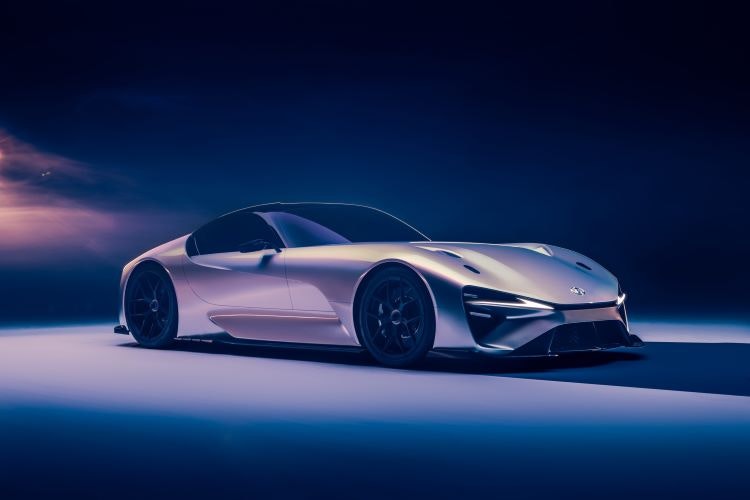
It was initially developed at Calty design studio in California, which is one of three Lexus design studios. Calty is responsible for designing innovative vehicles and advanced concept proposals for Lexus, as is the ED2 studio based in the hills of Nice in France. The Lexus Design Centre out in Aichi, Japan, is the hub of the company’s prototype design process and is where early designs for many new models are initially conceived.
Early this year at Calty, Shen and his team – chosen via an in-house competitive sketch exercise – began designing the Electrified Sport vehicle with a focus on aerodynamics. “One of the team found a cool video on aerobatic plane racing,” says Shen, referencing the vapour trails that the planes leave behind mapping out their dynamic flight path, which sparked the idea to include air as the central design concept.
The Calty team also wanted to pay homage to Lexus’ “Takumi spirit”. In Japan, the word Takumi refers to a craftsperson who is unrivalled in their field of expertise. As the company’s founder was originally a loom maker, impressions of weaving were designed into the vehicle. Shen explains that the front and rear of the car show examples of how “unlikely components are integrated together through weaving”, such as the tail lamp with the grill texture, and the undercarriage with the front corners.
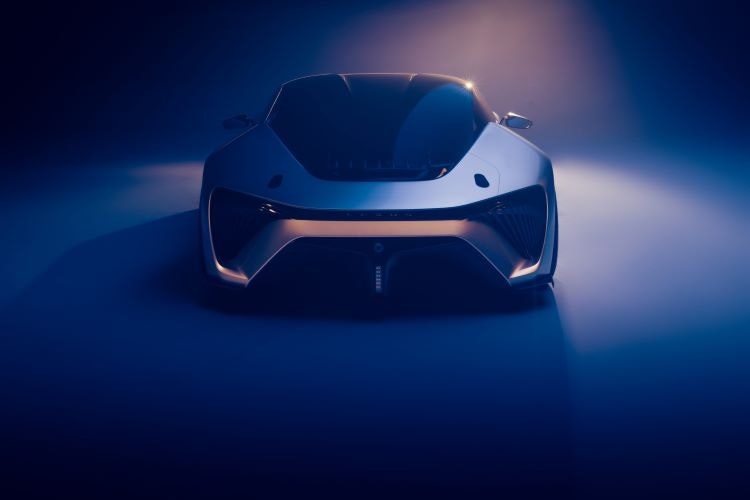
What’s next for Lexus?
The interior design of the Electrified Sports vehicle is yet to be revealed, but Shen says we can expect to see more of it soon, hinting that there is “a lot of innovation” involved.
He adds that Lexus is moving towards a “warm technology” approach to avoid it feeling cold or foreign to the user, especially in high-performance vehicles. “Some people like a lot of gadgetry and some don’t but you shouldn’t have to look at a manual every time you use it,” says Shen.
Performance-wise, he describes electrification as a “huge step” for Lexus, adding that we can expect to see elements of the electrified sport concept in future products. “There is a lot on Lexus’ plate right now, so you’ll probably see a lot more coming out very soon,” says Shen.
Lexus Shaped by Air Installation
During Miami Art and Design Week 2022 Lexus unveiled its Shaped by Air installation, inspired by the Electrified Sports vehicle and designed by Reddymade Architecture and Design founder, artist and architect Suchi Reddy. The brief tasked Reddy with “highlighting Lexus’ ethos” through the installation, which she says resonated with her curiosity about “how our environment affects us and how we affect our environment”.
When Reddy saw the car for the first time, she says it was lower than she imagined it would be, describing it as “wide and flat with beautiful curves”. She also compared the car’s design to the work of French artist Henri Matisse, describing its “similar lines, shapes, cut-outs”.
The process started with tracing over a picture of the car, which was then separated into various cut-outs. Reddy says that her goals was to make something “as ethereal as possible” because a car is such a solid object.
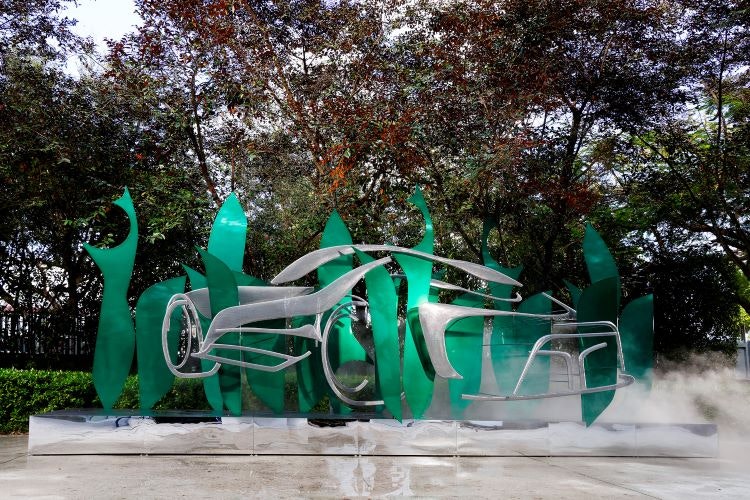
Post-consumer metals sourced in the US make up the main bulk of the sculpture, which was bashed into shape using a double ended mallet – one leather side and one metal side – around wooden templates. Reddy explains that she purposely designed a “complete abstraction of the car” that could be made in “an analogue way” that is very different to how a car is made on an assembly line.
Mist and light were incorporated into the sculpture to “represent the shape [of the car] through non-solid forms”, according to Reddy. She says: “Even when you look at the real car when it’s still, it looks like it’s moving because of the lines and aerodynamic design.”
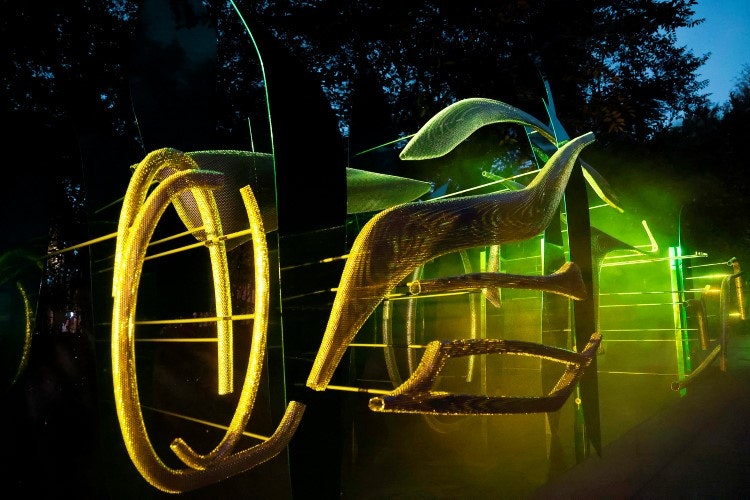
She sought to add the same effect to the sculpture through the incorporation of light, which she says chases over [the installation] like headlights in a fog”. As it gets darker in the evenings, the effects of the lights and the mist become more exaggerated, emphasising the ethereal nature of the sculpture.
Reddy believes that breaking down the friction between the automotive and natural worlds “is not an easy thing”. Despite this, she says that the piece has allowed her to “take an idea and bring it into the physical world to give people a different perspective”.

- Design disciplines in this article
- Industries in this article










